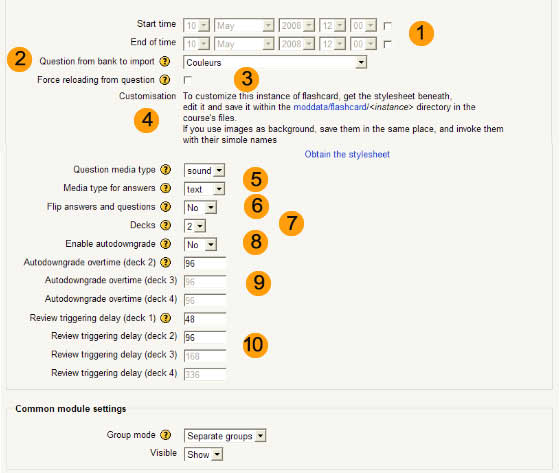Flashcard module: Configuration Parameters
Time range (1)
The time range parameters allow to define an aperture time slot for the module. If disabled, the module is available at any time, pursuant it is set to visible state.
Question to Import (2)
You can ask the module to import a "matching question" from the question bank. You must check the "force reload" option to import the questions (see below).
Force Reloading (3)
You must check this box to have question definitions imported within the flashcard question set.
Customization (4)
This is not really a parameter, but some indications about how to customize the flashcard appearance. Teachers can use course files to change the stylesheet. Needs some very little skills in CSS.
Media Type Selectors (5)
Both dropdown lists allows selecting a media type for question and/or answers. Question and/or answer could be textual, image or sound. Media type can be selected independantly for question and answers.
Flip Answers and Questions (6)
Checking this box will swap question and answers so question become answers and reverse.
Decks (7)
A number of decks can be choosen, from 2 to 4.
Using 2 decks will be usefull for small sized cardset (up to more or less 12), or for memorizing easy things.
The standard Leitner system uses 3 decks, that should be enough for medium size sets as vocabulary lists. Set size of 20 to 50 items should fit in the 3 decks system.
4 decks may be used for large lists, or for medium lists that present memorization difficulties (such as questionning with images that have a lot of semantics in, or very alike sounds). 4 decks should be used on a larger training period, as all cards must be able to go 3 decks down to complete the exercise.
Enable Auto Downgrade (8)
If disabled, the cards will remain in their current deck forever (or until the game has not be reset by teacher).
If enabled, the cards will jump up to a harder deck after a delay, if the student do not review the cards. Completing the exercise may be harder if there is no regularity in the memorisation work.
Auto Downgrade Delay (9)
These fields will allow fixing the delay (in hours) the cards will jump up to a harder deck. The delay is counted relatively to the end of the review time.
This delay can be setup distinctly for each deck.
Review Triggering Delay (10)
These fields will allow setting the delay a user should come review the deck. The autodowngrade delay will start counting after this review delay is elapsed.
This delay can be setup distinctly for each deck.
